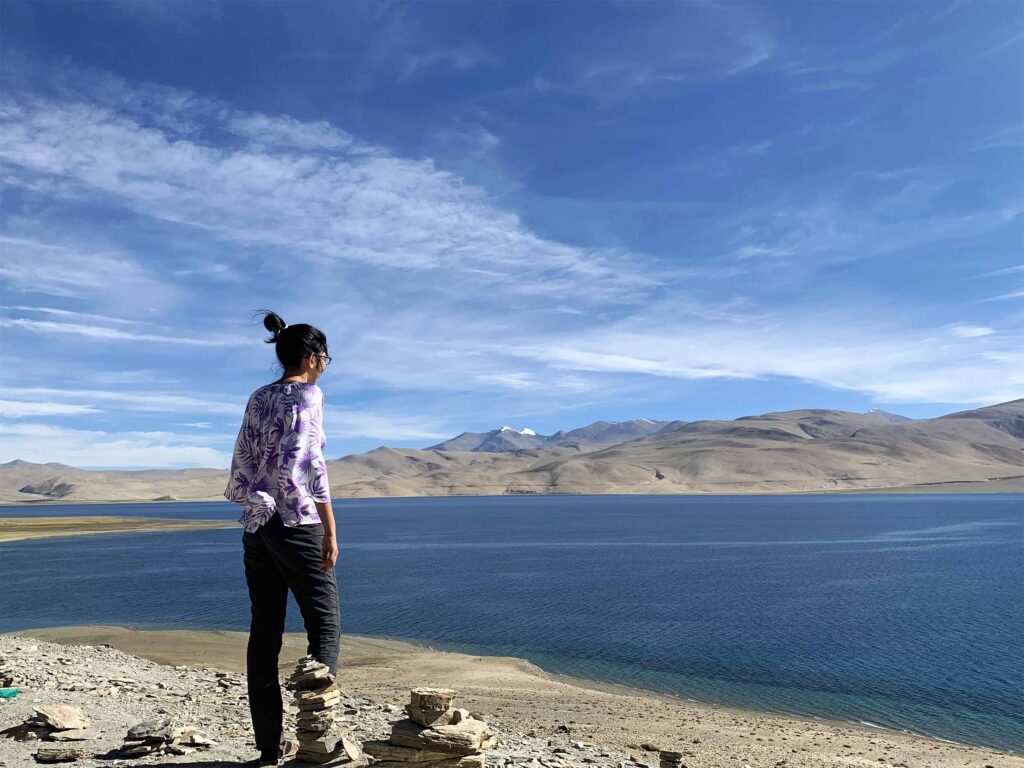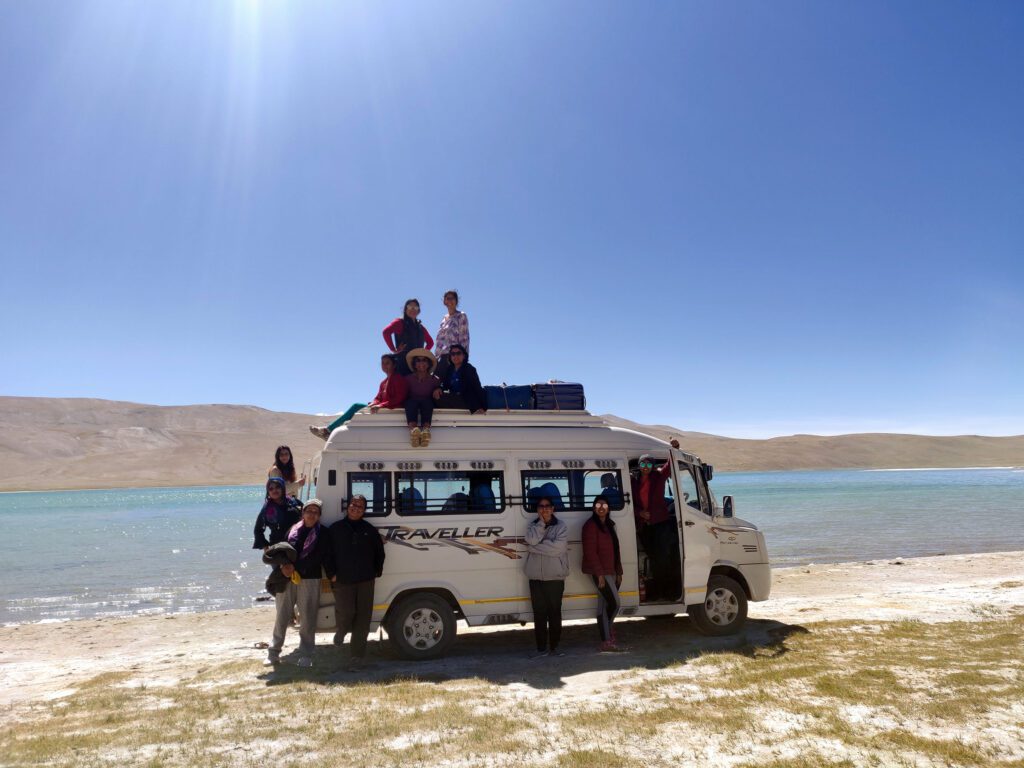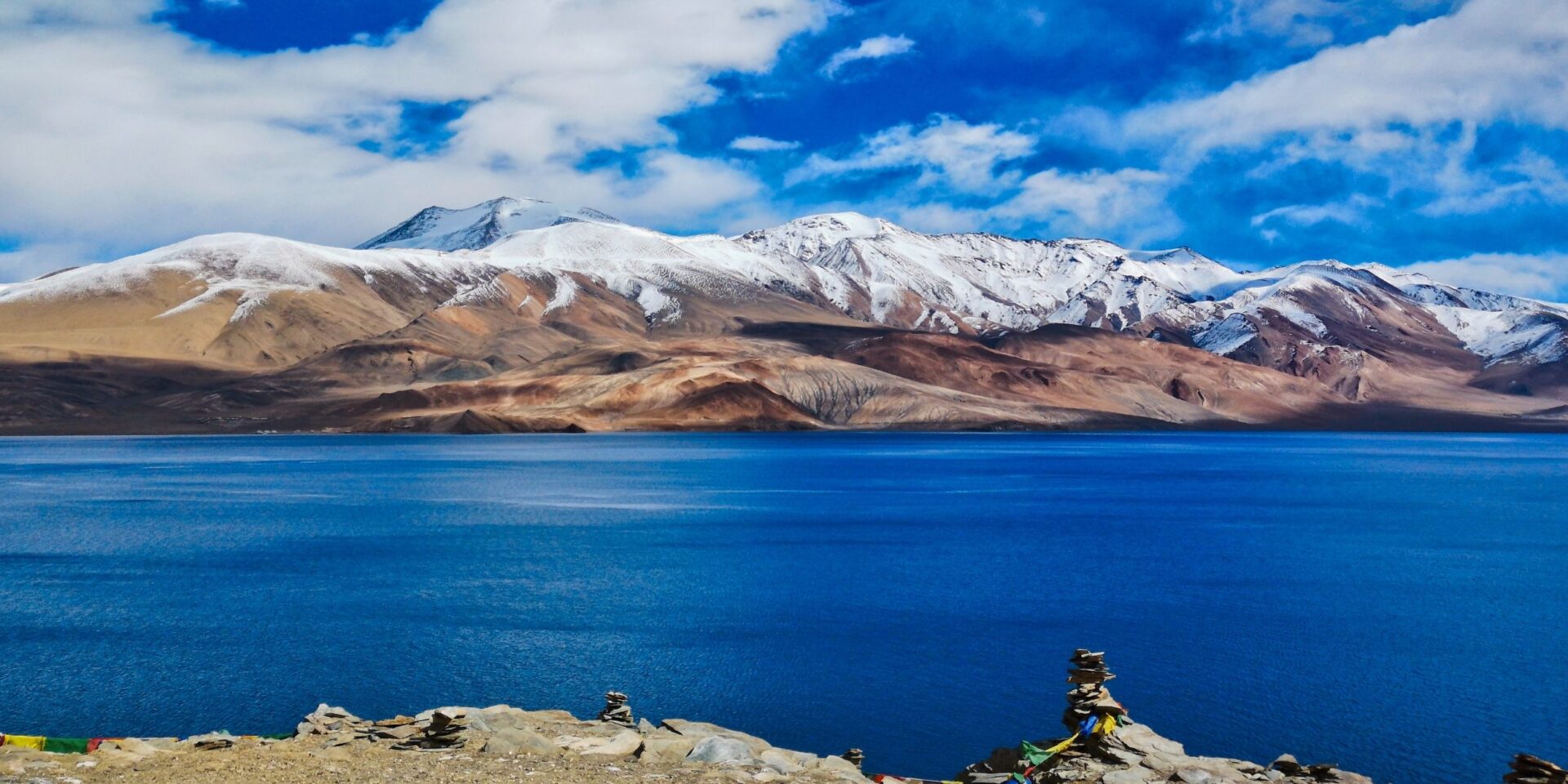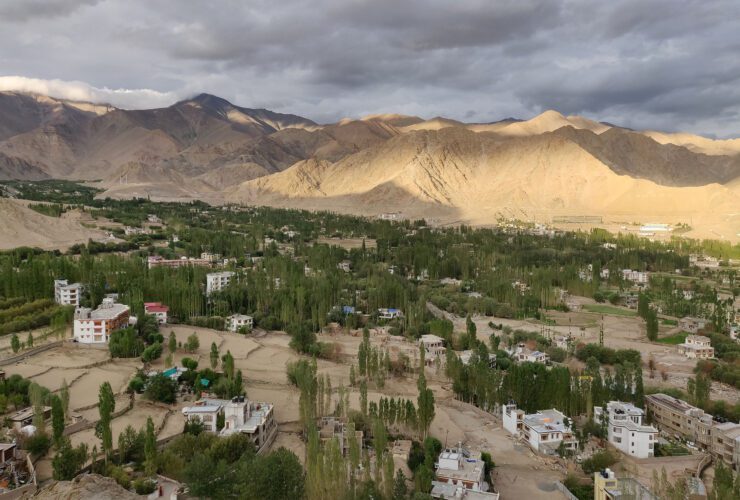One…Two…Three – take a deep breath. A vision of blue with streaks of mountain grays and browns, speckled with the whitest clouds and patches of green spread all over. That’s what you see when you reach Tso Moriri. The half-moon shore, with tiny pebbles and rocks covering the bed of the lake, just makes you want to jump into the pristine waters. The only thing stopping you is the cold air hitting your face. For a moment the beauty of the lake almost makes you forget how high up you are, but for that one moment, you truly feel like you’re in paradise.
Introduction to Tso Moriri Lake
Nestled between mountains, in the Rupshu Valley of lesser Ladakh, the Tso Moriri is the lesser-known cousin of the Pangong Lake. Situated at an altitude of 4522 meters above sea level, Tso Moriri is an abode of serenity and beauty. The entire picture of the snow-capped grayish-brown mountains exists in sharp contrast to the clear, blue waters of the lake. Stretching across the landscape for about 19 kilometers the lake is frequented by a range of wildlife including migratory birds, marmots, and on rare occasions, the Tibetan wolves. Tso Moriri is part of the wetland reserve under the Ramsar site, the highest of its kind, and is known as the Tsomoriri Wetland Conservation Reserve. Due to this status, no one is to pitch any tents or construct any structure near the banks of the lake.
Did you know?
- The name “Tso Moriri” itself directly translates to “Mountain Lake”, the word “Tso” in Tibetan means ‘Lake’. Therefore calling it ‘Tso Moriri Lake’ is actually the wrong nomenclature.
- Unlike Pangong Lake which lies in China as well, Tso Moriri lies completely within India.
- Apart from the obvious fact of how you shouldn’t jump into waters in freezing temperatures, you aren’t allowed to jump into all the lakes in Ladakh (and Spiti Valley as well) for several reasons!
Where is Tso Morriri
Tso Moriri is located in the Rupshu Valley of the Changthang region of Ladakh about 250 kilometers southeast of Leh, in India.
Things to do at Tso Moriri Lake
1. Tsomoriri Viewpoint
The Tsomoriri viewpoint is a small hilltop near the lake and serves as a vantage point from which one can get a better view of the lake. Watching the sunset from this viewpoint is a photographer’s dream and can easily take anyone’s breath away. The changing hues of the lake with the reflections of the nearby snowclad mountains during sunset is mesmerizing.

2. Korzok Monastery
History lives and breathes within the walls of this 300-year old monastery founded by Kunga Lodro Ningpo, which is situated on the northwest banks of the Moriri Lake. Offering exquisite views of the Tso Moriri, this lake is a sight to behold. Housing the statue of Shakyamuni Buddha along with images of other deities, this monastery also has Thangka Paintings. These are traditional yet beautiful Tibetan Buddhist paintings that have been restored to their former glory in recent years. Visiting this abode of peace and offering a prayer is a blessing in itself.
3. Visit the Korzok Village
Following the Korzok Monastery, about 3 kilometers further north-west of the Moriri Lake is the Korzok Village. You can visit this rustic village and get a taste of the nomadic lifestyle of the Changpas, who are semi-nomadic Tibetan people. The surroundings of this village also serve as a great place to spot several animals like the Kyang (wild ass), Red Fox, and the highly endangered and rare – Snow leopard.
4. Chumathang Hot Springs
Enroute Leh to Tso Moriri, this little hamlet is situated on the bank of the Indus River. Since the Chumathang Hot Springs are at a lower altitude, it provides great relief especially to the people suffering from altitude sickness. This warm contrast to the cold Indus on one side provides the most comfortable atmosphere to kick back and relax after all the traveling. Many believe that these hot spring waters have medicinal properties. Whether that is a myth or not, is something one can only tell after having a soak in those luxurious waters.
5. Tso Kyagar
This is another lake that one must visit if they come to see Moriri Lake. Tso Kyagar is about 30 kilometers from Tso Moriri and with an elevation of 4705 meters, it is one of the highest salt-water lakes of Ladakh. This lake too offers amazing views and has an abundance of fauna to look out for, including Yaks and Kyangs. It’s a cute little lake with crystal clear water.

6. Bird-Watching at Tso Moriri
According to an avifaunal survey conducted in the year 1996, there are 34 species of birds that inhabit the Tso Moriri region, among which 6 species of water birds are considered vulnerable. So, this place is great for birdwatchers in search of exotic species.
Best Time to Visit Tso Moriri
The best time to visit Tso Moriri is the period between the months of June to September because cold places like this are most enjoyable during the summer months. Moreover, since that is the peak tourist season all facilities starting from accommodation to transport are available more easily and at more cost-efficient rates.
Weather at Tso Moriri
Tso Moriri in Summer
During the day, temperatures remain moderately warm and it is slightly comfortable. But at night, the temperature drops several degrees below zero and there will always be strong cold winds.
Tso Moriri in Winter
Winter in Tso Moriri is like any other place in Leh-Ladakh, temperatures can fall down to something as low as -25 degrees celsius or even more. Snowfall is also something you can expect in this season. The lake completely freezes during this time.
Acclimatization at Tso Moriri
Acclimatization is the process of getting accustomed to a new climate and weather conditions. It’s extremely important when traveling to places with higher altitudes like Tso Moriri or more Himalayan regions for that matter. If you ain’t acclimatized, you are prone to experiencing altitude sickness or Acute Mountain Sickness (AMS). It’s because at higher altitudes the air pressure is less and hence, lower oxygen levels, which makes it harder and harder to breathe. This is soon followed by symptoms like nausea, dizziness, headaches, and shortness of breath
Moreover, there aren’t any immediate medical facilities around. Therefore, it is extremely important to acclimatize yourself and adjust the body to the air around before moving higher up.
How to Avoid Acute Mountain Sickness (AMS) or Altitude Sickness at Tso Moriri
- Stay in Leh for at least 2 nights before coming to Tso Moriri
- Even if you have to use the washroom multiple times a day, always remain hydrated while on the go
- Refrain from smoking or drinking during the entire duration of your trip in the region
- Don’t undertake strenuous physical activity and exert yourself
- Get proper sleep
- Don’t overeat and get proper meals instead of filling your stomach with chips, Maggi, cup noodles, or any kind of junk food.
- Carry proper medication such as Diamox, which you can start taking a day before your arrival in Leh.
Note: It is highly advised that you consult your doctor or physician before taking Diamox or any other medicine. Firstly because Diamox is essentially a sulphonamide blood thinner and there are people allergic to sulfa drugs. Secondly, Diamox has several side effects like nausea, dizziness, and frequent urination
Things to Remember before planning a trip to Tso Moriri
These are some things you must keep in mind and know about before planning a trip to Tso Moriri:
Cell Service
You will not find any cell service at or around Tso Moriri. Regardless of which service provider you use, you will not find any network, even with BSNL or MTNL. Moreover, only postpaid services work in the limited areas of coverage. BSNL has the largest area of coverage in the region, being available in the entire Leh town, Nubra valley, Kargil, Drass, the Sham region, Changthang, and Zanskar. You might find some coverage on the way but the connection will probably be very weak.
ATM Facilities
There are no ATMs near the Tso Moriri area. The most advisable alternative is to carry cash from Leh because it is the only place in Ladakh with functioning ATMs. In fact, please ensure that you do carry cash at hand either from the beginning of the trip or from Leh
Medical Facilities
There are no hospitals or dispensaries in Karzok or any doctors in general. Although, you may find basic first aid in the Karzok village near Tso Moriri not always. The nearest hospital is in Leh, therefore it is best to carry your own basic first aid kits equipped with bandages. Carry basic medicines for fever, headaches, upset stomach, and pain relief sprays. It is also advisable that you carry your own oxygen cylinders.
Inner Line Permit – Tso Moriri
Since Ladakh is next to the Indian Border, several places in this region are considered as a part of the inner line (i.e. areas that are close to the Indian border) and Tso Moriri is one such place. Therefore, it is mandatory to get an Inner Line Permit before visiting Tso Moriri for both Indian Nationals and a Protected Area Permit for Foreigners.
Indian nationals can apply for an Inner Line Permit either online or get it directly in person from the District Commissioner’s office in Leh. Foreign visitors, need to get a Protected Area permit before they are allowed to travel from Leh to Tso Moriri. They can obtain the permit online or in-person through a registered travel agent.
Note:
As of Aug 2021 the Ladakh govt. has removed the Inner Line Permit thing for Indian Citizens. Click here for reference. Although, do check with your travel agent or any reliable source before leaving for Ladakh.
Packing List
- Thermals, 2-3 pairs (Most essential)
- For summers, any sports shoes should be fine but for winters it is a must to carry a pair of well-insulated boots or trekking shoes.
- Woolen socks, 2-3 pairs
- Heavy woolens like Sweatshirts, pullovers, warm hoodies, 2-3 sets
- Comfortable trekking/traveling pants or trousers
- A heavy woolen wind-proof jacket or parka is good to carry even during summers in case the weather changes
- Caps or Hats to protect against the suns
- Balaclava or Monkey cap especially for the winter months
- Sunglasses protect your eyes from the reflections from the snow
- Hand gloves are a must during winters or cold nights during summer.
- Carry sunscreen, a first aid kit, and medicine for Acute Altitude Sickness.
- Carry your own water bottle to be economic and it’s better for the environment, plus you’ll need to keep yourself hydrated constantly.
- Toilet Paper and Wet Tissues
How to reach Tso Moriri
There are several routes to reach Tso Moriri but the ones most used are the Pangong Lake to Tso Moriri and Leh to Tso Moriri. Although one can always take the ‘road less traveled by, it is best to stick to these two routes since most of the other routes have bad road conditions and go through isolated regions. Both of the routes I am about to suggest to you are the best ones to use for ease of transportation and availability of facilities on the route.
Leh to Tso Moriri
The route from Leh to Tso Moriri that runs through the Chumathang Valley is the shortest and most used one. The total distance covered in this route is around 220 kilometers. Travel time can be anywhere between 6 to 7 hours depending on your travel speed and the breaks you take in between. If you are planning on traveling by public transport, this is the only route available to you.
Route: Leh to Tso Moriri via Chumathang
Leh – Shey – Kharu – Upshi – Kumdok – Kyere – Chumathang – Mahe – Sumdo – Namashang La – Karzok (Tso Moriri)
Leh – Upshi (49 km)
Start early from Leh and then take the Leh-Manali highway, by which it is another 35 kilometers to reach Kharu. En route, you can stop at the Shey, Thiksey, Stakna, and Hemis monasteries for a quick glance and a prayer for the journey. Then from Kharu, you will follow the Leh-Manali for another 14 kilometers until Upshi, which is a good place to stop for snacks and refreshments. Authorities will check your Inner Line Permit at the traffic check post in Upshi and ask you to submit one copy of your permit.
Upshi – Chumathang (91 km)
From this point, you will be diverting from the Leh-Manali highway and taking the small road on the left which goes to Kyere village. As you keep going, you will gradually start to gain altitude, from 3,400m at Upshi and gain steadily to 4,050m at Chumathang. The road from Upshi to Chumathang is a mix of both good and bad roads. At Chumathang you can stop by the hot springs and pamper yourself with a hot steaming bath. The hot water springs also have medicinal benefits.
Chumathang – Tso Moriri (73 km)
After crossing Chumathang, the roads are mostly dirt tracks. Eventually, you’ll arrive at the Mahe Bridge checkpoint where you’ll have to submit a copy of your permit. Once you cross this checkpoint, you will continue via Sumdho and soon you’ll start the ascent for Namshang La pass. Right after the pass, you will come across the beautiful Kyagar Tso with its blue turquoise color waters. After driving for another 20 km, you will finally reach the Tso Moriri lake.
Pangong Lake to Tso Moriri
The route from Spangmik to Tso Moriri via Chushul and Sumdo is the shortest and most used route. The total distance covered in this route is 217.2 km, and the travel time can be anywhere between 5-6 hours or more depending on your travel speed and the breaks you take in between
Route: Pangong Lake to Tso Moriri via Chushul and Sumdo
Spangmik – Man – Merak – Chushul – Loma – Nyoma – Mahe – Sumdo – Karzok (Tso Moriri)
Spangmik – Chushul (45.3 km)
Start early from Spangmik and start driving on the dirt track along Pangong lake. It’ll be a very pretty drive despite the condition of the road since you will get to see some amazing views of the lake. For the most part of this journey, you will continue driving on a dirt track.
The first place you’ll reach is the village of Man. From here continue towards Merak where there’ll be a checkpoint and you will be required to show your permits. After completing your registration, you’ll continue towards Khaltse and from there to Chushul. A tip here would be to follow the electricity wires. These wires connect these villages and will ensure that you do not take a wrong turn somewhere where you might end up in trouble with the Indian Army. Once you reach Chushul, you can take a quick break and visit the Chushul War Memorial, dedicated to the heroes who lost their lives in the Sino-Indian war.
Chulshul – Nyoma & Mahe (85.3 km)
From Chulshul, head towards the high-altitude pass of Tsaga La. At Tsaga village, you’re again required to register yourself at the ITBP Checkpost. After this, you’ll see that you are back on the solid road for the first time in this route. This road is pretty good and continues till Loma, where you’ll have to register yourself again. So far, the journey may be getting a bit tedious and even if you are stopping for a break, please do not get out of your vehicles in Loma because the stray dogs in this area are known to be especially vicious. From the check post in Loma, take a right turn towards Nyoma and Mahe. It shouldn’t be more than a 90-minute drive. Once you reach the Mahe, there’s another checkpoint where you once again register yourself, and then next to this checkpoint is a bridge on your right that will lead to Sumdo. In case, you are unable to locate this deviation, please ask for directions at the checkpost or the locals around.
Mahe – Sumdo – Karzok (86.6 km)
After a little while, you will arrive at Sumdo village where you can take a small break and eat something here. From here the route may get confusing if you are not with a local tour guide, so ask the locals of the village the way to Karzok. Once you have ascertained the way, you will begin your descent down Namahang La. After a few kilometers, you will be back on the dirt tracks till you reach Karzok (Tso Moriri). You will come across another lake on this path, the Kiagar Tso.
Make sure to follow the most prominent path here or follow some Sumo or Bolero which are run by locals so that you continue on the right route. Around 10 km before you reach Karzok, you’ll come to a bifurcation. This means you have followed the right track, so now at this bifurcation, keep going straight and do not turn left since that road goes to Chumur. You might see roads that say ‘Road Closed’ but pay no heed, keeping going straight without turning left, and voila! You will have reached Tso Moriri.
Accommodations
Tso Moriri is a remote and sparsely populated area. The availability of basic amenities like electricity and running water is a luxury in itself there. Hence, one must remember that you cannot expect the frills of popular tourist destinations like Manali. Yet, don’t be discouraged because you will be surprised that these places offer more than just a place to stay.
Since the Tso Moriri is a protected wetland, there are no tented colonies directly next to the lake itself. Although, you’ll find a decent number stay options a few hundred meters away fromd the banks. You can either pitch your own tents near other campsites or find accommodation inside the Korzok village. Mind you, some of these campsites do have proper beds and attached toilets which is nothing but a luxury. There are quite a number of homestays or guesthouses in the Korzok Village, which offer an amazing experience of their traditional ways of living. Moreover, no matter where you stay, you get a full view of the lake in all its glory. Watching the sunset across the lake, the colors of the crystal clear water changing from shades of blue to shades of yellow and orange, as you sip some hot beverage from your tent or homestay room doesn’t seem like such a shabby idea does it!
How to be an Ambassador of Responsible Tourism at Tso Moriri Lake
Part of the reason why the beauty of Ladakh is so untouched is that the locals and the visitors have always been conscious of this space, so as not to ruin it in any way. So, let’s not be the first ones to do the opposite. You can be a Responsible Tourism ambassador at Moriri Lake by following some simple etiquette:
- Don’t litter around. Follow the No Trace Left Behind (NTLB) policy
- Don’t enter the water or take a bath in the lake. People who follow the Buddhist faith in Ladakh consider their waterbodies to be holy. Hence, they prohibit tourists to go inside them. Now you know why the water bodies of this region are so clean!
- Don’t run around or physically expend yourself and get exhausted
- Do not smoke, drink alcohol, or do anything else that would lead to AMS
- Refrain from making loud noises during your stay at Tso Moriri because its beauty lies in its silence
- Respect the cultures of this region and its people. Try not to comment on their way of living or the absence of certain facilities
You can also read our Responsible Tourism blog post that gives more tips on the same.
Conclusion
The beauty of Tso Moriri cannot be contained within a few thousand words. It is as vast as the clear blue skies above it. To be one with nature is a feat mankind fails to achieve in our daily lives, but one can find that to align themselves with earth and all that it gives us is a journey many have begun at a place like Tso Moriri. Just follow this guide and you are going to have a memorable experience.
So come join us in this journey of a lifetime. We organize a women-only group tour to Ladakh and a mixed-gender group tour to Ladakh every year. If you already have a group of people, we can organize a customized package for you as per your requirements.



